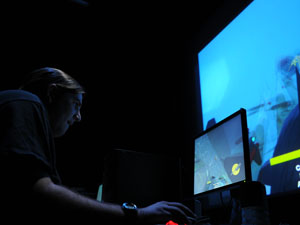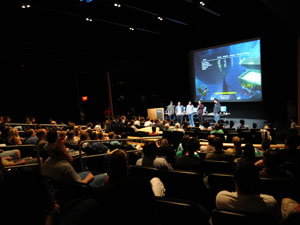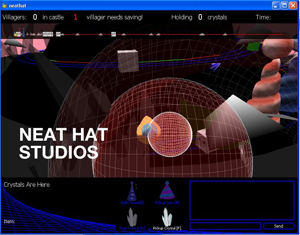UCSD Computer Science Undergraduates Showcase Multiplayer Online Games at Calit2
By Tiffany Fox, (858) 246-0353, tfox@ucsd.edu
San Diego, CA, June 10, 2008 -- As the deadline for CSE 125 final projects drew near, the most sought-after item among undergraduates in UC San Diego's Software System Design and Implementation course wasn't a high-speed computer or fancy piece of visualization software.
|
The fruits of these students' long labors – four networked, multiplayer 3-D video games – were showcased in front of a packed auditorium June 6 in Atkinson Hall, home of the San Diego division of the California Institute for Telecommunications and Information Technology (Calit2). The presentations coincided with the close of the 2007-'08 academic year, and for many students in the class, with graduation from UCSD's Jacobs School of Engineering.
Computer Science and Engineering Professor Geoffrey M. Voelker, a Calit2-affiliated researcher, says the CSE 125 course only has one assignment: to create a distributed, real-time, 3-D multiplayer video game.
|
And they had to get it all done within 10 short weeks.
In the final days of preparation, students rarely left the computer lab, ordering in food and hunkering down at laptops well into the morning hours. "The separation between night and day does not exist," commented a student who completed the course in a previous year. (Hence the aerobed.)
|
At the final demo in Atkinson Hall, audience members were invited to play each of the games while a representative from each group explained the team’s approach. A team calling itself "Neat Hat" presented "Neat Defense," a game in which players build passive defensive towers to protect a village from invasion by "creeps." The game, which was designed to run on Windows, Mac OS and Linux, holds the rare distinction of being a "cooperative" game in which players have to work together to achieve a common goal.
More often in video games, players compete to destroy one another, as was the case with the other three games presented at the event. A team called Leviathan Productions presented their aquatic-themed creation, "20,000 Frags Under the Sea," a first-person shooter game that pits heavily-armed piranhas, groupers and barracudas against each other in a battle for ocean domination.
|
Team Undecided Chaos and Shape Destruction’s creation was "Island Mayhem," another third-person shooter game in which players throw items like beach balls and bananas at one another in an effort to control a tropical island. When players are “damaged” by their competitors, they turn a sunburned shade of red.
Calit2 hosts the final presentations of CSE 125 as part of its ongoing effort to encourage undergraduates to participate in R&D while still undergrads. Other programs supported by Calit2 for undergraduates include the Calit2 Summer Scholars program, and the NSF-funded Pacific Rim Experiences for Undergraduates (PRIME) program, which allows undergrads to spend the summer working on cyberinfrastructure projects at research institutions in Asia and Australia.
|
Media Contacts
Tiffany Fox, (858) 246-0353, tfox@ucsd.edu
Related Links
CSE 125 Software System Design and Implementation






